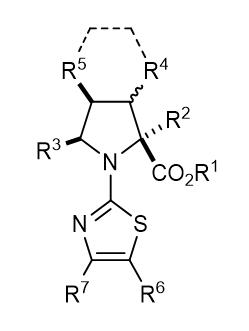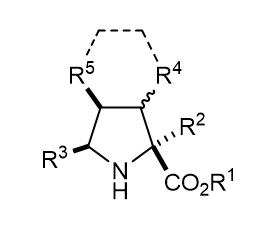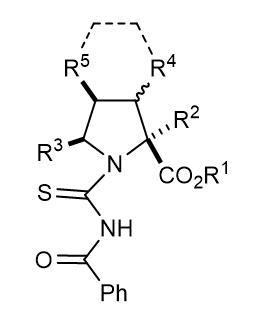Never miss an update from Universidad de Alicante
Create your free account to connect with Universidad de Alicante and thousands of other innovative organizations and professionals worldwide
The Institute of Organic Synthesis at the University of Alicante has discovered a new family of molecules that can effectively combat bacteria resistant to conventional antibiotics, including tuberculosis.
TECHNICAL DESCRIPTION
In order to solve the problems described above, a new family of molecules has been discovered that can effectively combat bacteria resistant to conventional antibiotics, including tuberculosis.
The present invention refers to a set of molecules or compounds with the following general formula (see Figure 1), as well as to a pharmaceutically acceptable formulation (ester, carboxylic acid or carboxylic acid salt) comprising at least one compound of the following formula:

Figure 1: Thiazoles with a pyrrolidine ring as a substituent and their acid derivatives
These compounds can be synthesised in the laboratory in three simple steps under mild reaction conditions:
1. Pyrrolidine or pyrrolidine derivative is obtained by reaction of iminoesters and electrophilic alkenes via a 1,3-dipolar reaction (see Figure 2).

Figure 2.
2. A condensation reaction of the above pyrrolidines with benzoyl isothiocyanate is then carried out (see Figure 3).

Figure 3.
3. Finally, haloketones are added to the synthesised thioureas to obtain the final thiazole-pyrrolidine structure (see Figure 1).
TECHNOLOGY ADVANTAGES AND INNOVATIVE ASPECTS
ADVANTAGES OF THE TECHNOLOGY
This novel technology has the following advantages:
1) Antibiotic efficacy demonstrated in in vitro tests.
2) Less degradation in the biological environment.
3) Greater therapeutic effect.
4) High antibiotic activity against different bacteria resistant to conventional antibiotics.
5) Greater specificity towards antibiotic-resistant bacteria, including Mycobacterium tuberculosis, an infectious disease that is increasingly difficult to treat with existing antibiotics.
6) Enables treatment of infections that were previously difficult or impossible to cure due to bacterial resistance.
7) Potential to prevent future resistance by being effective against bacteria that have already developed resistance to other antibiotics.
8) Wide field of application in the field of pharmaceutical chemistry and medicine in general.
9) The synthesis procedure of these compounds is very simple: only three steps.
10) The synthesis procedure is carried out under mild reaction conditions.
11) The synthesis procedure allows good yields of the final compound.
Its potential to save lives and prevent future resistance makes it a valuable and promising technology for the future of medicine.
INNOVATIVE ASPECTS OF THE TECHNOLOGY
The main innovation lies in the molecular structure of these chemical compounds, which allows them to be effective against bacteria that have developed resistance to other antibiotics, representing a very significant advance in the effective fight against this type of bacteria, which is a growing and worrying problem worldwide.
The new compounds described in this patent can treat a wide variety of infections caused by resistant bacteria, which can significantly improve the therapeutic options available.
These molecules can be used as active species against different types of microorganisms, preferably in the prevention and/or treatment of infections such as tuberculosis.
CURRENT STATE OF DEVELOPMENT
The technology described is at an early stage of development (Technology Readiness Level: TRL = 4), but has great potential to address one of today's greatest medical challenges: antibiotic resistance.
These compounds have been shown to be effective in in vitro assays at the laboratory level, suggesting that they have great potential to be a valuable tool in combating infections caused by resistant bacteria. However, more clinical trials are still needed to determine the safety and efficacy of these new compounds in humans.
The patent describes several specific examples of chemical compounds and their antimicrobial activity against different bacterial strains.
The cytotoxic activity of the molecules described in the present invention was tested using different lines of microorganisms to establish their antimicrobial efficacy in in vitro studies. For this purpose, antibacterial assays were performed with different molecules against standard bacterial strains of Staphylococcus aureus [ATCC 25925], Bacillus subtilis [ATCC 6633], Aeromonas hydrophila [ATCC 95080], Escherichia coli [ATCC 25923] and Acinetobacter baumannii [ATCC 02026]).
An anti-tuberculosis assay was also performed to determine the minimum inhibitory concentration (MIC) of the newly synthesised compounds against the standard strain H37Rv of Mycobacterium tuberculosis.
The bioactivity results correlate with the presence of different substituents at various positions of the general formula structure (see Figure 1), and may induce higher bioactivity by modifying certain substituents at specific positions.
COLLABORATION SOUGHT
Currently, there are no commercial products related to these structures. In this sense, companies interested in acquiring this technology for commercial exploitation through patent licensing agreements are sought.
Company profile sought:
• Pharmaceutical industry.
• Chemical industry.
Ahead of the current Coronavirus outbreak, Innoget is fully committed to contributing to mobilizing scientific and expert communities to find a real solution to the Covid-19 pandemic. Therefore, we're supporting worldwide calls and programs that could help in any aspects of the coronavirus crisis.
Is your organization promoting or looking for innovation or research initiatives to mitigate the Covid-19 outbreak? Email us at covid19@innoget.com to list them.
Channeled through Innoget's online open innovation network, initiatives in the health, virology, medicine, or novel technologies applied to human health, among others, are listed and disseminated to Innoget members -ranging from hospitals, research institutes, scientists, businesses, and public administrations- and innovation partners worldwide.
Create your free account to connect with Universidad de Alicante and thousands of other innovative organizations and professionals worldwide
Send a request for information
to Universidad de Alicante
Technology Offers on Innoget are directly posted
and managed by its members as well as evaluation of requests for information. Innoget is the trusted open innovation and science network aimed at directly connect industry needs with professionals online.
Need help requesting additional information or have questions regarding this Technology Offer?
Contact Innoget support